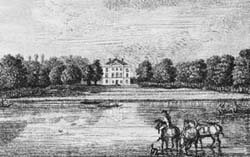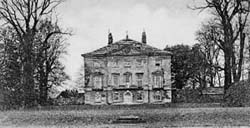Marble Hill House
A Palladian Mansion for a Royal Mistress
1724 - 1729

Marble Hill, so named after a “shot”(an old term for a parcel of land) on the estate, was built on land acquired for Henrietta Howard (1688-1767), later Countess of Suffolk and one time mistress of George II. Building started in 1724 and was completed in about 1729. The house, designed in the newly fashionable Palladian manner was built under the supervision of Roger Morris and the gardens laid out by Charles Bridgeman, aided by Alexander Pope. Later, at least one grotto was constructed in the grounds and one survives.
Pope and his friends Jonathan Swift and John Gay showed an interest both in Mrs Howard and her wine cellar which, during the summer of 1727, they more or less emptied. Swift thought that her gardener, Moody, passed too much time spending his wages tippling in the Dog and Partridge. Pope regarded Mrs Howard as that rare being, "a reasonable woman, handsome and witty, yet a friend". In later years Horace Walpole became a close friend, enjoying the pleasures of gossip over strawberries and cream.
Later Occupiers
When Lady Suffolk died in 1767 the estate passed to her brother's son, the 2nd Earl of Buckinghamshire. He, on occasions lived there but also rented it out, in 1768-9 to John Halliday. Lord Buckingham died in 1793 and Marble Hill passed as a life interest to Lady Suffolk's great niece, Henrietta Hotham. She soon abandoned the house to tenants, living herself either at Little Marble Hill or in Richmond. She died in 1816. Amongst the tenants during this period were Mrs Fitzherbert (1795/6), Lady Bath, Viscount Howe, the Dowager Duchess of Bolton, Charles Augustus Tulk, and Edward Fletcher.
The House Sold
In 1824, Miss Hotham's heirs broke the entail on the estate, and sold Marble Hill to the Army Agent Timothy Brent then living in Little Marble Hill. In the following year he sold the property to Jonathan Peel (1799-1879), the younger brother of Sir Robert Peel. Jonathan Peel was a peace time soldier and an MP. Without seeing action, he eventually, by purchase and long service, ended as a General. He was also Secretary for War in Lord Derby's first ministry. Peel, a religious man was also a keen race horse owner. Two of his horses came first and second in the controversial Epsom Derby of 1844.
In 1876 Peel acquired the grounds of Little Marble Hill ( the house having been demolished).Peel died in 1879, and his family dedicated memorial windows to him in St Stephen's Church. His widow, Lady Peel remained in Marble Hill until her death in 1887. The contents of the house and a prize herd of cattle were auctioned off, but the house and grounds remained unsold.
The Black Walnut that still stands in the grounds, down by the river was planted at this time. It is probably the oldest remaining Black Walnut in the country.

Threat of Demolition
In 1898 the property was bought by the Cunard family (then living close by at Orleans House) for £36,000 with the intention of creating a suburban housing estate: plans for roads and drainage were prepared. Vocal opposition backed by funds raised from individuals and various local authorities secured the property for public use at a cost of £70,000 in 1902.

In public ownership
The London County Council (later the Greater London Council) held it in trust until 1986, when the GLC was abolished. English Heritage then took charge of the property. In the 1960's and, while in their care and supported by voluntary work, much has been done towards restoration of the interiors, and latterly to the grounds.
Further reading:
Marie Draper and W A Eden, Marble Hill and its owners, Greater London Council, 1970
Dictionary of National Biography
English Heritage Reports 1989.
David L Jacques, Land tenure at Marble Hill, 1720-1820, unpublished typescript, 1995




